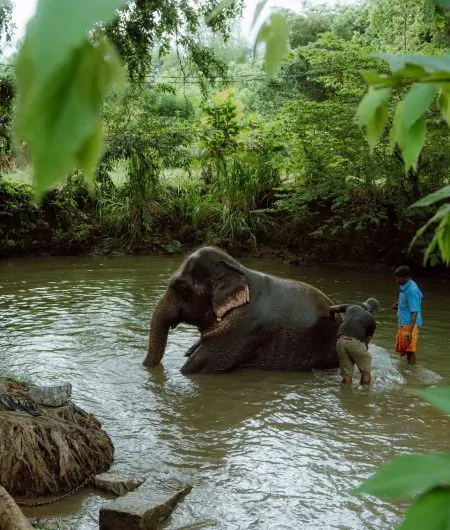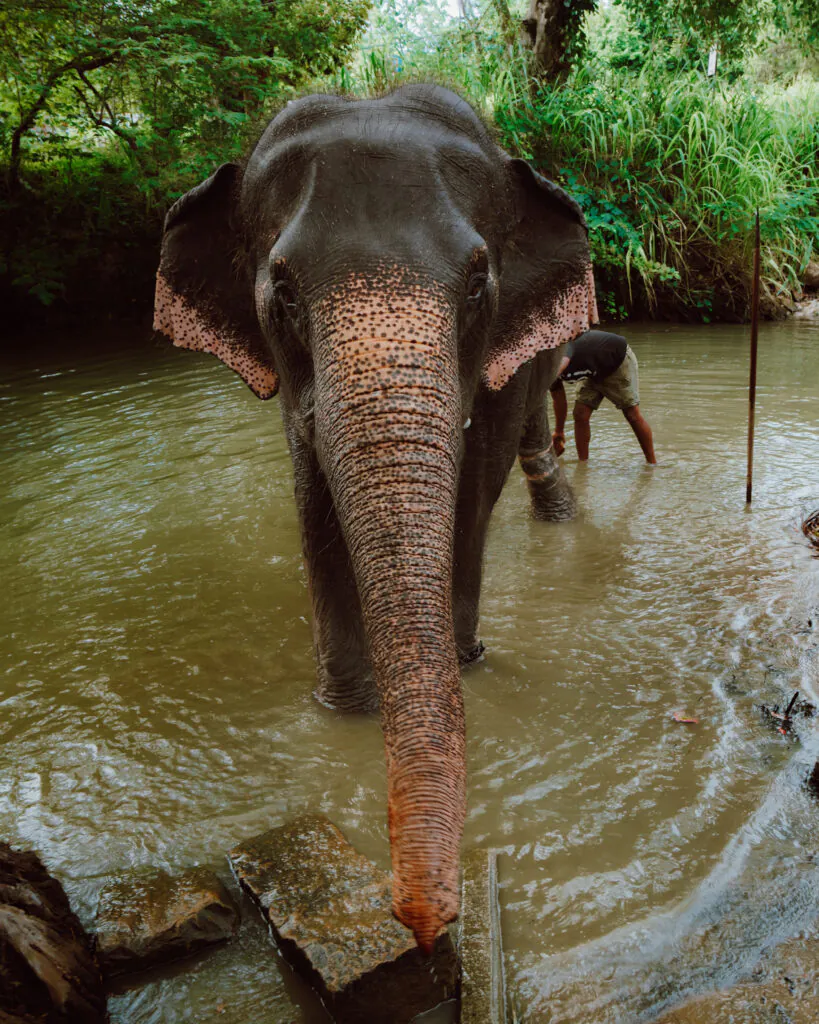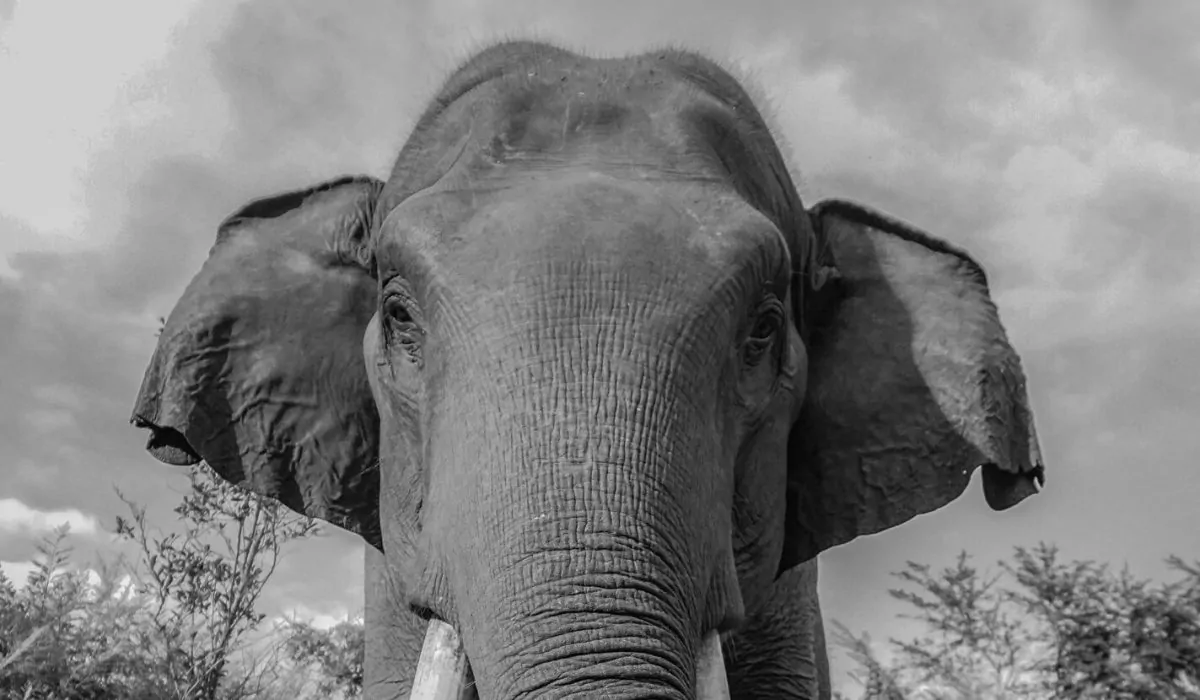Menu
Sri Lanka, the tear-shaped island nation at the tip of India, is renowned for its stunning beaches, lush jungles, and rich cultural heritage. But amidst these treasures lies another wonder: the majestic Sri Lankan elephant. These gentle giants, a subspecies of the Asian elephant, hold a special place in the island’s history and ecosystem.
Giants with a Storied Past:
For centuries, elephants have woven themselves into the fabric of Sri Lankan life. Revered in religious traditions, depicted in ancient art, and employed in royal ceremonies, they remain deeply embedded in the national identity. Today, around 7,000 elephants roam the island, primarily in the dry zone sanctuaries like Minneriya, Yala, and Udawalawe National Parks.
Witnessing Wonder in the Wild:
Imagine the thrill of encountering a herd of elephants grazing peacefully in the golden grasslands, their wrinkled trunks reaching for leaves or playful calves frolicking in the water. Jeep safaris and guided nature walks offer unforgettable opportunities to observe these magnificent creatures in their natural habitat. Responsible tourism operators prioritize ethical practices, ensuring minimal disturbance to the elephants and their environment.

Beyond Safaris: Conservation Efforts:
The future of Sri Lankan elephants hinges on careful conservation. Habitat loss due to human encroachment and conflict over resources pose significant threats. Fortunately, numerous organizations are working tirelessly to protect these iconic animals. From establishing elephant corridors to mitigating conflict situations, their efforts offer hope for a future where humans and elephants co-exist peacefully.
Experiences Beyond the Wild:
While national parks offer the quintessential elephant encounter, other experiences allow deeper connections. Elephant orphanages provide care for rescued calves, where visitors can observe their heartwarming journeys towards rehabilitation. Ethical elephant sanctuaries prioritize the animals’ well-being, offering opportunities for responsible interaction and education.
Nestled in the heart of Sri Lanka’s south-central plains lies Udawalawe National Park, a haven for diverse wildlife. Yet, among its inhabitants, none reign supreme like the magnificent Sri Lankan elephants. With an estimated 600-700 individuals calling this park home, Udawalawe offers a unique opportunity to witness these gentle giants in their natural splendor.
A Sanctuary for the Endemic:
Unlike their African cousins, Sri Lankan elephants are a distinct subspecies smaller in stature but no less majestic. Their tusks are shorter and straighter, and their distinctive rounded foreheads set them apart. Udawalawe, with its vast grasslands and the life-giving Udawalawe Reservoir, provides the perfect habitat for these herbivores. Witnessing them graze, bathe, and socialize in herds is an experience that will leave you breathless.
Beyond Sightings: A Glimpse into Elephant Life:
The park offers more than just fleeting glimpses. The Udawalawe Elephant Transit Home, established in 1995, serves as a sanctuary for orphaned or injured elephant calves. Here, you can observe their heartwarming journeys towards rehabilitation, learning about their social structure, communication, and intelligence. Witnessing the dedication of caretakers who nurture these vulnerable creatures back to health is a humbling experience.

Beyond the Giants:
While elephants undoubtedly steal the show, Udawalawe boasts a rich tapestry of other wildlife. Leopards slink through the grasslands, water buffalo wallow in mud pools, and colorful birds flit amongst the trees. Keep your eyes peeled for crocodiles basking on the banks, and don’t miss the chance to spot the elusive sloth bear, a critically endangered species that finds refuge in the park.
A Legacy to Protect:
Udawalawe National Park is a vital sanctuary, not just for elephants but for the entire ecosystem. The park faces challenges like habitat loss and human-elephant conflict. By choosing responsible tourism and supporting conservation efforts, you can play a crucial role in safeguarding the future of these gentle giants and the breathtaking wilderness they call home.
Your Udawalawe Adventure Awaits:
Udawalawe National Park promises an unforgettable encounter with the majesty of Sri Lankan elephants. Come experience their fascinating world, learn about their importance, and become a responsible visitor who contributes to their continued existence. Remember, the echoes of their trumpets and the sight of their majestic forms will forever be etched in your memory, reminding you of the wonders that nature holds.
Nestled in the heart of Sri Lanka’s North Central Province lies Minneriya National Park, a haven for wildlife and a stage for one of nature’s most breathtaking spectacles – the Elephant Gathering. This annual phenomenon draws hundreds of Asian elephants to the park’s ancient Minneriya reservoir, transforming the landscape into a sea of grey giants.
The Gathering: A Feast for the Senses:
As the dry season descends, transforming lush landscapes into parched plains, the Minneriya reservoir emerges as a lifeline for thirsty elephants. From May to September, herds from surrounding areas converge on the park, their numbers swelling to over 300, some reports even suggesting as many as 700. Witnessing this gathering is an experience etched in memory. The air thrumming with trumpeting calls, dust swirling as the giants bathe and graze, and the gentle swaying of their trunks create a symphony of sight and sound unique to Minneriya.
Beyond Numbers: A Glimpse into Elephant Society:
The gathering isn’t just about survival; it’s a social event. Mothers introduce their young to the herd, playful calves chase each other, and dominant males spar for dominance. Observing these interactions allows a rare glimpse into the complex social structure of elephants, their intelligence, and their deep bonds.
More Than Just Elephants:
While the elephants undoubtedly steal the show, Minneriya National Park boasts a diverse array of wildlife. Spot leopards lurking in the shadows, witness the vibrant dance of painted storks, or catch a glimpse of the elusive sloth bear. The park’s diverse habitats, ranging from grasslands and scrub forests to wetlands and the Minneriya reservoir itself, provide a haven for over 170 species of birds and 78 species of mammals.

The Pinnawala Elephant Orphanage, nestled amidst the lush countryside of Sri Lanka, evokes a spectrum of emotions. For some, it represents a haven for rescued calves, offering a chance at a life they wouldn’t otherwise have. Others raise concerns about animal welfare and the ethics of captive breeding programs. Amidst this complexity lies the truth about Pinnawala, its achievements, and the ongoing debate surrounding its practices.
Origins and Purpose:
Founded in 1975, Pinnawala aimed to provide a safe haven for orphaned and abandoned elephant calves. Sri Lanka’s rapid development often led to habitat loss and conflict between elephants and humans, leaving vulnerable young elephants in need of care. Over the years, the orphanage has successfully raised and released several elephants back into the wild, contributing to conservation efforts.
Beyond Rehabilitation:
Pinnawala has expanded beyond its initial purpose, becoming a popular tourist destination. Visitors can witness daily mud baths, bottle-feeding sessions, and even elephant safaris within the orphanage grounds. This revenue helps fund the care of the elephants and supports ongoing conservation initiatives.
However, concerns about animal welfare are often raised. Critics argue that the elephants at Pinnawala spend most of their time in confined spaces, lacking the natural roaming behaviors and social interactions crucial for their well-being. Additionally, the practice of captive breeding, while aimed at increasing the elephant population, raises questions about the long-term viability of releasing these animals back into the wild.
The Pinnawala Elephant Orphanage acknowledges these concerns and emphasizes its commitment to animal welfare. They highlight improvements made in recent years, including increased access to grazing land, enrichment activities, and a focus on natural elephant behaviors. Additionally, they emphasize the ongoing research and collaboration with international organizations to improve elephant care and explore potential reintroduction programs.
The future of Pinnawala hinges on finding a balance between its role as a sanctuary, its economic dependence on tourism, and the ethical imperative of prioritizing animal welfare. Continued transparency, open discussions, and collaborations with conservation experts are crucial.
Activities
Observing the elephants:
This is the main activity that most visitors come for. You can watch the elephants as they roam freely in their enclosures, bathe in the river, and interact with each other.
Feeding the elephants:
You can participate in the feeding sessions, which take place twice a day. You can buy milk, bananas, and other fruits from the vendors at the orphanage to feed the elephants.
Elephant mud bath:
Witness the elephants enjoying a refreshing mud bath in the river. This is a popular activity, and it’s a great way to see the elephants playing and having fun.
Elephant museum:
The orphanage also has a small museum where you can learn about the history of the orphanage and the elephants of Sri Lanka.
More than just Selfis : Responsible Ways to Connect with Elephants as a Volunteer
Do you want to work in an orphanage where animals sick and injured are looked after? Does learning from experienced elephant handlers and living with volunteers in a lush environment appeal to you? If it does, enroll in our elephant orphanage project in Pinnawala and have a life-changing volunteer experience.
Located in 25 acre of land and next to the river, the orphanage is an ideal place for the elephants that are injured and sick to recover. The elephants in Sri Lanka are often domesticated to run errands that fetch money. They do work like carry loads and tourists on their back, but once sick and injured, the elephants become a burden for their owner. That’s when the orphanage takes care of the elephants and rehabilitates them. The orphanage currently has 84 elephants at the center and offers personal care and protection to them.
Join the project and experience elephant care, or contact us to find out more.
elephant project gallery

Your Responsibility as a Volunteer:
Volunteers will live close to the elephant orphanage and spend their day working with the elephants. Your work starts at 8.30 am and lasts for 3 hours. In the morning, your duties include helping the elephant handlers to clean the enclosure, prepare milk and other food, bottle feed baby elephants, and feed the other elephants.
Work will be relaxed and carried out in a fun way. You will be served lunch after your morning work ends.
In the afternoon, volunteers will go to the river to see and participate in the elephant bathing ritual. You will also learn from mahouts how to clean the elephant with coconut husks. You will work for 2 hours from 2 to 4 pm.
Skills Required:
We do not require any specific qualifications and experiences to work in this project, but you must be fit and in good health. You should, however, have a love and compassion for animals, especially for elephants. You must also arrive with an open mind and with a passion to learn new things in a strange environment.
Project Location:
This is a very rural project located in Pinnawala, in central Sri Lanka. The project is situated in a lush 25 acre sanctuary and has over 80 elephants. During your free time, you can visit ancient historical cities like Anuradhapua, the first capital city of Sri Lanka, and Polonnaruwa, where you can explore the ancient ruins of the temples built by the ancient kings. You can hike to “SIGIRIYA ROCK” and witness spectacular scenery from there. You can also visit northeast Sri Lanka, home of famous beaches like Arugam Bay beach and monasteries, temples, parks, churches, museums, art galleries, etc.
Arrangement of room/food/supervision:
Volunteers will stay at a hostel close to the project. You may have to share the room with other volunteers of the same gender. There will be a ceiling fan, individual beds, and mosquito nets in your room. There will also be electricity, a washing machine and TV for you to watch in your free time. While in the project, volunteers will also be provided 3 local meals in a restaurant opposite of the project. The food will be fresh and nutritious, but it will also be slightly spicy as all Sri Lanka meals are spicy. While in the project, our staff will also regularly call you to see if you are facing any problems, and will try to tackle those issues immediately.
Photo credit goes to Thilina Kaluthotage & Budhi Nilukaha
WhatsApp us